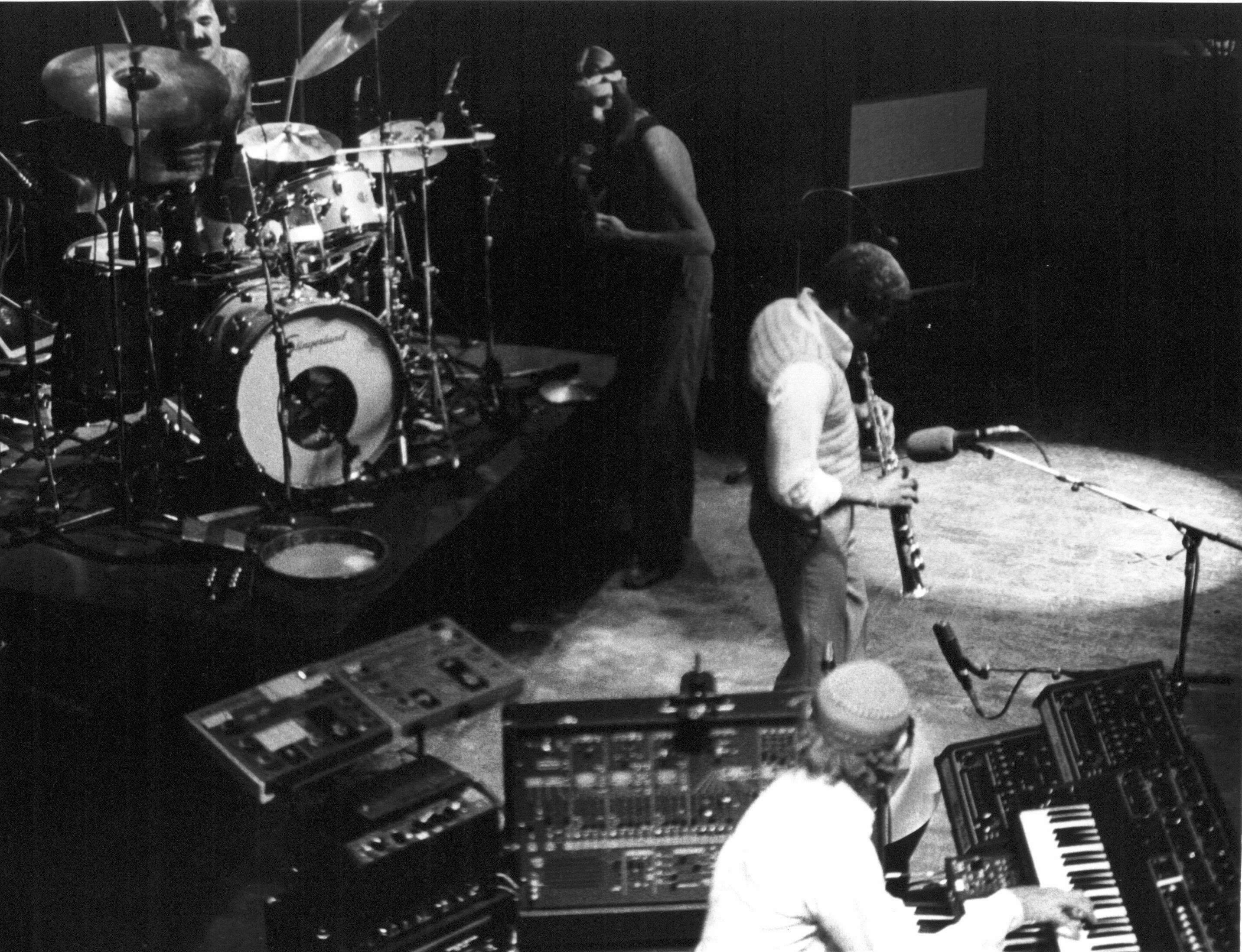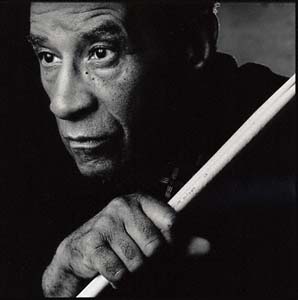
Second blog post of the day from me, and this one's not really one I'd have wanted to make, but, as Corporal Nym says in Shakespeare's 'Henry V', "things must be as they may." So it is then, that the latest jazz great to pass away this year (in what is becoming a regular procession), is Canadian pianist Oscar Peterson, who died last Sunday at his home near Toronto, aged 82. This tribute post is a brief assessment, not in terms of chronological terms, or career, but what his style as a whole meant and contributed to jazz. It's not entirely positive: I have to confess that I've no really been that thrilled with Peterson's style - I'd rather hear any number of other pianists: Tyner, Hancock, Powell, Monk, Ellington, even Basie. I just feel they have something which OP doesn't. But then again, his success, both critical and commericial, speaks for itself, and he was certainly one of the top men in the music.
"He fills his work with riffs and repeated figures, sometimes a single note hammered out relentlessly. This approach offers rhythmic intensity, but from a melodic point of view it often leaves his lines fragmented and somewhat chaotic." (James Lincoln Collier, 'The Making of Jazz')
Collier devotes only one paragraph to Peterson in his history of jazz, and while his judgements can sometimes be rather old-fashioned (to give two examples, he makes a valiant attempt to understand the modern avant-garde, but ends up going down the old simplistic conclusion that it's simply a lot of angry chaos; and his dismissal of Miles Davis' soloing style is also rather peremptory), I think what he says about Peterson does have some relevance.
He lumps together Peterson, George Shearing and Errol Garner as three pianists who had a wider impact on the public than the perhaps ultimately more important Art Tatum, Thelonious Monk and Bud Powell -
they constitute a subschool of modern piano playing. All three were working with established styles before either Monk or Powell recorded. They thus began as swing pianists...before the beginning of the bop movement. All of them to one degreee or another moved into the new music, but none of them was firmly committed to it, and the swing feeling has always remained an important element in their playing. All of them were rhythmically forceful; all of them concentrated on popular standards instead of originals or the more difficult bop tunes; all of them tended to present the song's original melody frequently in a performance. This combination of straightforward driving rhythm and recognisable tunes in an idiom that owed much to swing made their music a good deal more accessible to a broad public than the music of Monk, Powell, and the beboppers...taken together, [they] were the major architects of a light jazz piano style that has become central to modern popular music.Cocktail pianism, pehaps, as Collier goes on to imply, and I think the critic does a good job in capturing the somewhat old-fashioned feel that pervaded Peterson's output. (Someone in a review of Dave Brubeck's latest album said the same thing about him, which is an interesting point of comparison).
Maybe that was what attracted him to the public - he ploughed his own furrow all the way through the noisy experimentation of bebop, then the 60s New Thing and jazz fusion, carrying on in basically the same style, and often the same group (trio, with bass and either drums or guitar - though of course he was a sensitive and prolific accompaninest to the likes of Louis Armstrong, among others, despite serving no real apprenticeship as a sideman - he went straight into being a leader with a much-heralded debut, and never looked back). As Colin Larkin puts it in the Guinness guide to jazz: "he has maintained a certain steady consistency of style that has withstood the buffetting of fashion." This consistency, this steadiness, meant that you could always be certain that he would deliver a performance that was at the very least capable and polished and proffesional, at best truly inspired.
"Nearly everything Peterson plays, he plays with the same degree of force. He leaves no holes for the rhythm section." (Miles Davis, 'Miles: The Autobiography')
"Peterson's powerfully swinging style does tend on occasion to overpower his melodic sense and he is apt to become repetitious, and, less often, banal. After four decades in the business, though, he understands its workings better than anyone. Above all, Peterson delivers." (Richard Cook and Brian Morton, 'The Penguin Guide to Jazz on CD')
As the above quotes illustrate, he wasn't exactly subtle, with all those enormous arpeggios and glissandi, and thick, heavy chords threatening to swamp things. Sometimes it seemed as if he'd got carried away with the dizzying brilliance of his own virtuoso technique, and was deciding to show it off - sometimes he didn't employ his undoubted gifts in the best way he could. He might have learned from Miles or Wayne Shorter or Herbie Hancock to leave space, gaps, breathing points; he might have learned from McCoy Tyner how to build inexorable momentum, and then to sustain the climax at a pitch of intensity for minutes at a time. I don't think he really did, though, more's the pity. In contrast to Bud Powell's modernist shidangle, Peterson's virtuosity is almost schmaltzy - more Liberace than Rachmaninov. Still, that said, it's not as though every piece becomes a showcase for virtouso display, irrespective of the needs of the tune; Peterson was a fine ballad player, if lacking the gift for space that many of the jazz musicians had (Bill Evans especially).

As a little personal aside, my favourite Peterson album turns out to be the one that Cook and Morton describe as the single OP record you should own (I purchased it before reading their review, incidentally), a rather obscure 'Compact Jazz' compilation containing performances from Peterson's 1960s heyday, with various trios (all of them featuring Ray Brown in the bass spot), and trumpeter Clark Terry guesting, in puckish, sprightly (if slightly subdued) form on a couple of tracks. A particular highlight is the opening piece: his reading of 'Let's Fall in Love' is irrestistible, full of delicious virtuoso flurries of Tatumseque intensity. And the way he plays the melody seems somehow just right - he catches it spot on. Also on the record are excellent versions of 'The Shadow of Your Smile', 'Autumn Leaves', his ballad 'Wheatland', which manages to convey a sense of shimmering, slightly melancholly delicacy and down-home gospelly fervour at the same time, and John Lewis' sober tune, 'Django': in comparison to the composers' performance with the MJQ, Peterson's reading of the main melody is that of a sentimentalist (Brown's accompanying bowed bass work is faultless), before he moves on to an easy, trickling, tinkling blues solo.
OK, back then to summaries, to evaluations of legacies (which I suspect I am uniquely unqualified to give)...In many ways, OP defines what most people's idea of jazz piano is. Other modern greats - Tyner, Monk, even Hancock -are more modern, more idiosyncratic, but OP IS jazz tradition, and played with the makers of that tradition (Armstrong, Holliday, Fitzgerald). I guess it wouldn't be stretching it too much to describe him as something of a populist, yet and that's unfair, in that it implies he had no artistic integrity, which is certainly not true. What it all boils down to is the fact that I shouldn't let my personal prejudices cast too big a cloud on a pianist who was capable of performances of undoubted greatness, so, R.I.P., O.P.
And finally...A fascinating short animated film from 1949 called 'Begone Dull Care', made by film-maker/artists Norman MacLaren and Evelyn Lambart in collaboration with Peterson, who improvised the music, over a 4-day period. The abstract images conjured up (by painting and scratching directly onto film-stock) resemble some of William de Kooning's charcoal-like paintings in the black-and-white accompaniment to the 'first movement', and Jackson Pollock's colour splashes later on (though the visual style is unique), and might thus seem somewhat inappropriate to Peterson's basically rather old-fashioned, traditional style, but the result is never less than fascinating.


























